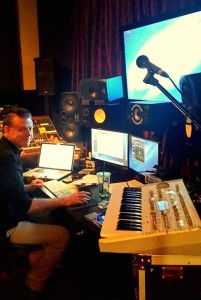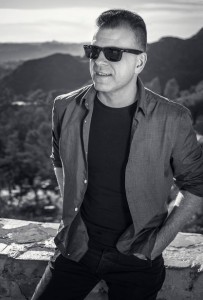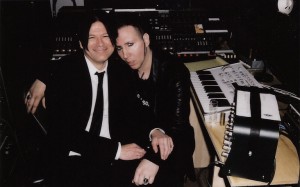Producer/Engineer Sean Beavan on Mixing Metal, Industrial & Indie Films
As a producer, mixer, and audio engineer, Sean Beavan has worked with Nine Inch Nails, Marilyn Manson, Slayer, Guns N’ Roses, and No Doubt. He uses distressed gear, sampling, and innovative recording techniques to create sounds that haven’t been heard before.
Although Beaven’s work has predominantly been in metal and industrial music, he has recently branched out by mixing actress Jill Hennessy’s country/folk album I Do, as well as making his film scoring and sound design debut on two new indie films.
What is it about heavier genres like metal and industrial that attracts you?
I have always liked the visceral natural of them. There is a big cathartic release of power and energy between the bands and the audience. They speak to each other in a way that respects each other.
The bands and producers are not trying to pull something over on the audience. They are invariably huge fans of the genres, as well as creators, and they are making the music because they are driven by a love for it.
When you were mixing Slayer’s album God Hates Us All, how did you approach the vocals, given all the tuned down guitars and overdrive? How did you manage all that distortion and heft and avoid masking?
I love that record—Thanks for mentioning it. It was an honor to work with Rick Rubin and Matt Hyde on that record. Coming from NIN, my industrial background really helped. Since I’m used to navigating symphonies of distortion, adding artificial vocal distortion to the Slayer lexicon was relatively simple. The tuned-down nature of the guitars lends itself to Tom’s raspy tenor, and to ensure that the upper ranges of distortion weren’t masking each other I tried to sculpt specific points for each of the players.
If I was accenting the 2kHz to 3kHz range in Jeff’s more soulful tone, I was giving Kerry more bigness in the bottom and slice in the 5k range—which left 4k for Tom’s edge and allowed me a bit of 8k for some harmonic “air” as well. The worst thing you can do in those situations is turn up the same range of upper mid frequency on the guitars and vocals. You’ve got to be discrete..
Do you prefer recording drums in any particular way?
Of course, it depends on the vibe and what the instrumentation is going to be and the genre itself. You wouldn’t record the drums the same way for a Jazz combo, or a dark swampy blues band, or a dance pop act, or a metal band. Each has its own distinct expectations and tropes. I like my drums to have drama and impact and character—so I try to apply those three things to the particular genre being recorded.
It gets really fun when a band is trying to create a genre like SHINING did for it’s Blackjazz records. Then you get to create or sound design for something new. Of course you use what has come before to inform where you are intending to go. I like to record to drums to tape using a 16-track head onto 2” tape on a Studer A800 MkIII machine at 15ips for rock. Then, I dump it into Pro Tools to edit. If the budget doesn’t allow for that I prefer to just record into Pro Tools at 48k 24 bit. To me analog or digital is no better or worse. They are just a texture and a choice. Both offer remarkable and terrible things.
When it comes to drum mic’ing, where you place the mics is as important as how you tune the drums and the character of the drums themselves. When you are recording, you’ve got ti make sure you love what you hear before you press record. That way you will never be disappointed later.
Unless, of course, you know that you are going to be doing tons of post work to create unnatural sounds then anything goes. But in the end if you don’t have what you want then make it what it can be. Use your imagination, get inspired. Of course, in order to do that you need to know what you want it to be and that is what makes you an artist.
I know you have a lot of the Overstayer gear, which you don’t see a lot everywhere. What do you like about that line?
Jeff Turzo at Overstayer is a musician and producer first, so his ideas electronics-wise are really musical. Whenever he comes to me with a new piece of gear it feels like he was reading my mind.
I use his new Master and Servant on the mix bus [after] my Alan Smart C1 compressor. I know it does some saturation type effects with the 2nd and 3rd harmonics that just makes it feel like the mixes are bigger than the speakers, and the stereo field feels more detailed and discrete. It sounds like voodoo. It’s magic, which is what you want from gear.
For tracking, I use two versions of his mic pres. One has a FET limiter that I use for practically everything I bring in DI-wise—especially bass. It just sounds like a great clean amp. His channel amp with the Pultec-style EQ is my go to for recording acoustic guitars. Since I got that one, I have not recorded an acoustic without it.
I always use his old stereo FET compressor on room mics for drum recording, but it is also great on the drum buss for mixing. It has a parallel compression circuit with a mix knob so you can crush it and dial in just the amount you want to add. Genius.
You recently expanded your studio, Redrum, to embrace 5.1 surround sound. Can you describe your setup in the control room?
When we moved from The Blue Room last year, we made the decision to create a hybrid studio where I could mix and record music for film as well as music. I have been making the transition to film composition and sound design and mixing for the last few years, and it has revitalized me creatively. Sometimes you just need to stretch your legs and expand your wheelhouse. It was time for me.
Redrum has worked out amazingly. We are able to jam with a full band and PA in the control room and it sounds amazing. [My wife] Juliette complains that her vocals never sound as good through the monitors when we play out. It only takes a flip of a switch and a couple of patches to go from stereo mixing to full dedicated 5.1 surround mixing
We have an old G5 and Pro Tools HD Accel 3 rig with wto 192 I/Os running Pro Tools 7.4 that I have used for mixing music projects for years. It has all my favorite go-to plug ins, and their still hasn’t been a better system made for recording music.
The system is set up all analog through my Neve and it runs though an analog mix-buss insert setup that includes my Alan Snart C1 buss compressor and The Overstayer Master and Servant which I then send back into Pro Tools to record mixes.
For film and TV and certain music projects we have a newer MacPro tower with an HDX setup running Pro Tools 10 and Abelton. We have a couple 192s that are digitally connected via TDIF to an O2R which is set up for drum recording and various live setups for jams etc. Plus, the analog ins and outs are all setup in the patch bays to interface with my old custom Neve console, with 1073 and 1066 mic pres.
It is a best-of-all-worlds scenario. We have a Vintage 1963 red sparkle Ludwig kit setup in one of the booths that is ready to go all the time and an upright piano in a second booth. Our amp room is stacked with a reissue blackface Twin, two Fender Deluxe Reverbs that have been converted to blackface specs, one of which has been additionally modded to the Bob Mould dual preamp specs. We also have a Marshall JMP head, a Roland Jazz Chorus, A Vox Pathfinder, a Galien Kruger bass amp and 4/10 cab, and a 1958 Fender Champ.
What did you learn from your experience working on Guns N’ Roses’ album Chinese Democracy?
Patience. [Laughs] I learned what an earnest artist and loyal guy Axl is, and how funny he can be. He is one of the best joke-tellers I have ever met, and he knows a million of them. Axl was an absolute perfectionist. I respect that.
“Simple Kind Of Life” on No Doubt’s Return of Saturn [by No Doubt] is a great song. What do you recall about working on that track—or the album in general?
Adrian and I would start by riffing on grooves trying to one up each other on groovaliciousness. I would then go into the control room and Karl Derfler would hook up my wa-wa, distortion, and delay pedals to whatever I asked him to—usually the Snare—which he would bus to me, and I would play along in real time, mutating the sounds as we recorded. It seemed to provide the band with excitement and to help springboard ideas that made things uniquely No Doubt.
They were always really responsive to ideas; like the groove of the hook in “Ex Girlfriend.” They really have no ego when it comes to songwriting. It’s all about making something great. There was so much love between the members of that band it was great to be around. I loved working with Gabe McNair their keyboard player as well, he has a creative musical mind.
How did you approach mixing I Do for Jill Hennessy?Did you make changes in the way you normally work, since you were working with lighter, more acoustic folk and country sounds than usual?
Because the album has a more dynamic “musicians playing in a room together” kinda vibe, I mixed with the idea of giving the musicians’ natural dynamic more deference than I normally would in a heavier rock or pop track.
I usually use compression as an effect really, but here it is used in a more traditional role. Instead of the kind of heavy pumping drum buss compression I would normally go for, I used several layers of compression in a more gentle fashion to create texture, ambiance, and control, but still allowed the players more depth of expression.
Jill’s songs go from a whisper to a Springsteen like roar so it was a lot of fun and a challenge to keep it as real as she is.
I understand that you use Source-Live and Skype to work on mixes with bands in other countries. How well does that actually work?
Source-Live and Skype are how Jørgen Munkeby and I make those SHINING records. When we’re demoing material, Jørgen sends me MP3s, and and I throw them into Pro Tools and edit together ideas for arrangements and beat ideas as well. Then we get on Skype and discuss the ideas and work out musical figures. It’s easy to pick up a guitar and relay an idea or change a riff. It is exactly like being in a room together. We do the same when the band is tracking in Oslo. Jørgen can even spin the computer around in the studio and ask me if that is how I want the mics set up.
With Source Live, I can hear what they are hearing in real time in full fidelity. Mostly, we use it for making changes to mixes, and it means Jørgen can have me try stuff and make decisions right away. I usually mix at home by myself and then send the mixes to Jørgen who listens to them in his studio where he is used to the speakers.
When he comes up with ideas about how to tweak the mixes I can just route my Pro Tools session output through Source Live, send him a URL, and he can listen over his system in Oslo.
It really saves the back and forth time of sending multiple MP3s. Plus with his being, in essence, a Jazz improvisor, it provides the opportunity for some artistic synergy whenever we put our heads together.
You recently took on some of your first film scoring and sound design projects, June and Death Valley, What did that entail?
For June, [director L. Gustavo Cooper] was looking for an electronic score that felt a little late 70s early 80s, but also incorporated piano and some modern textures. The idea was to have quite a bit of score that not only did the typical horror film “be scared now” winks to the audience, but also added detail to the emotional arcs of the characters. This half indie art-house, quiet emotional movie, and half big-budget horror movie, so the score and sound design had to cover a lot of ground.
After we delivered the score, we went to a screening, and afterwards I was approached by Gus and the producers to re-approach the sound design elements and do the final mix of the film. Gus and I spent a week rifling through sound libraries at our friend and partner Dave Crocco’s A.G.E. Post soundstage in Burbank, and really had a blast ramping up the scare quotient.
Sound is really the lifeblood in the horror genre, so it was fun to watch the scares come to life. This was my first foray into film sound design but my NIN background helped a lot there too. And it didn’t hurt that I am a superfan of supernatural horror films, so I felt pretty uniquely qualified. Mixing film and music is essentially the same: Get unnecessary stuff out of the way to increase impact. I just went by instinct. And I read a lot of articles by Oscar winning sound mixers—I always do my homework.

For Death Valley, Juliette and I not only scored it, but I did production sound mixing and Juliette acted in it, and was script supervisor. So we were in the entire production from soup to nuts. It was a small and tight-knit crew working long days in Death Valley and everyone was wearing multiple hats and pitching in to make it all work. It was all-in, family style for Director TJ Scott who we love.
There were plenty of times while I was holding the boom with headphones on and I would hear these ethereal desert sounds and know that I wanted the music to make me feel the same way. It really helped to have the production experience when we shifted to scoring in post.
Our workflow when scoring is really simple and straightforward. We walk into the studio in the morning with our coffee and watch the five minutes of film. We talk about themes and what we need to accomplish in the character arcs, and then we search for atmospheres and sounds that inspire us to create the proper emotional landscapes.
For Death Valley’s main vibe, TJ had a list of movies that he loved score wise and so we knew what kinds of ideas he was looking for. He loves a simple repetitive main theme that can be used to evoke emotions in differing ways depending in the style and instrumentation so we used those types of motifs but he also let us get creative and explore other things as well.
Death Valley – Trailer by dreadcentral
What mistakes have you noticed that novice or aspiring engineers make, and what are the best ways for them to improve their craft?
I think the main issue is to listen to other mixes in the genre you are working in. Most beginners don’t listen and compare their mixes to ones they love, and then try to deconstruct and figure out why those mixes are bigger or more powerful, or more open and spacious.
Of course, being discrete with EQ is a big point as well. Think of the orchestra. There are reasons why instruments sound the way they do. They were made to compliment each other. A clarinet and a viola won’t mask each other—their waveforms are completely different as is a piano and a trumpet. figure out what sounds great about the instruments you are given in a mix, and accentuate that. Don’t just try to “fix” stuff. Spend more effort enhancing things and you will get great results.
Also, the best mixers start mixing by making a quick rough of what is there and then make judgements about what needs to change or be enhanced or fixed. Take the time to really listen to what you are doing, and how it effects everything around it, and remember that all of us are prey to “Louder Sounds Better”. It’s just human psychology, so when comparing things make sure they are at equal volumes or you’ll just think the louder one is better. We all do it.
Please note: When you buy products through links on this page, we may earn an affiliate commission.









